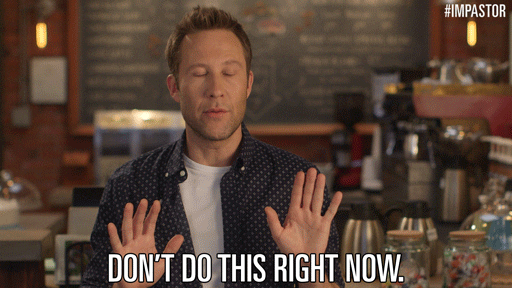Often a client’s first knee jerk reaction is to want to build their product on as many platforms as possible. “Our customers and our admins need to be able to access their account online and on a mobile app and maybe on a desktop program.”
And then when we suggest maybe only doing only one of those…they get…kinda hostile.

They think that we don’t believe in this big idea. Or we don’t want to help all their users. But, this isn’t it at all! By telling you no, what we really mean is that we want you to be successful! And successful when you’re a fledgling startup means starting small and focused.
We totally get it. You don’t want to miss out on an opportunity to connect with a potential user and their potential money just because they can’t access your product easily, but trying to build out multiple code bases without any initial customers or validation is a very. costly. mistake.

The first thing you should code up when starting a new product is an MVP…or a MINIMUM. viable product. Does building your first product for multiple users to access online, on phones, on tablets and on desktops sound very minimal? Nope.
So what should you do? Which should you pick? How do you even do that?

Don’t worry! We can take a quick look at a couple of different aspects to decide which platform is best to start with.
First let’s look at what kinds of tasks your product will contain.
- Will your users need to type in a lot of text?
- This will mean your product needs to run on something that has a real keyboard. (Web or Computer Program)
- Will your users need access to a camera or video? What kind of photos or video are your users needing?
- Is it candids like Snapchat (App)
- Or is it more meetings like Zoom (Web)
- Do we need the user’s location? How accurate does this need to be?
- If we’re offering some sort of running, fitness, or habits product we’ll need an app that can offer that hyper detailed data.
- If we just need to know nearby items (think Yelp) then maybe typing in our zipcode on a website works.
- Does this product need a really high level of visual polish or performance?
- Depending on its speed and visual needs, maybe don’t consider a hybrid app or web app for starting off.
Then look at where these kinds of tasks will be done.
- Are they needing to do these tasks while out and about? (Phone or Tablet App)
- How about offline/no service areas (Native Apps)
- Is this daytime, office work? (Web Browser or Computer Program)
- Is this an evening, couch activity? (Phone App / Responsive Web)
Who will be using this product?
- Kids? – Most kids use inexpensive tablets
- Office staff? Maybe custom software or web service or inexpensive android tablets
- Gen Z? New Moms? Senior Men? – Each demographic migrates to a certain kind of device depending on finances, habits, and age.
Now of course, people have varying habits and not every single user you talk to will say that they want to access your product in the same place. (In fact most users will say that they want more choice – even if their actual habits show them using the same devices over and over.)

So what you’re doing with this exercise is deciding which platform has the most logical overlap for all of these questions/answers for your target user.
Sidenote: Pretty much ALL of our advice at LunarLincoln involves touching base with your users and their needs. Make sure you genuinely understand your “core” user and remain focused on them. If you’re not sure how to do that just yet, check out our article on “Knowing your Users”.
Okay. I know more about where my users are and what this product might need, now what?
Now, pick ONE PLATFORM for your MVP.

Only one? Really? But…but…I can’t! I need them all. This way I don’t miss out and ALL of my customers are always happy. Please can’t we just build for web and mobile and desktop and tablet?

Nope. For your MVP, building for one platform will help you in a myriad of ways.
- It helps save development time and money
- It reduces churn when you need to change or tweak features
- It even allows you to focus your marketing for that initial launch only in places and with groups that will use the platform you’re on.
These sound like good things right? Not doing ALL the things IS a good thing. I promise.

Also, just because you launch with one platform doesn’t mean you’re barred from expanding for all time. If you have amazing demand, then this means you’ll also have more money and information from users to know where to go next (build that Android app! Add that desktop version!)
If you over build and were *gasp* maybe a teeny bit wrong about your users, then you have a big ol’ technical piece that is getting dusty, is underused, and is likely still costing your financial resources to maintain.
Don’t be this creepy, empty castle subdivision in Turkey.

If you feel pretty confident about knowing what your user’s want and where they are but still need help determining the technical solutions, we’re happy to help.

